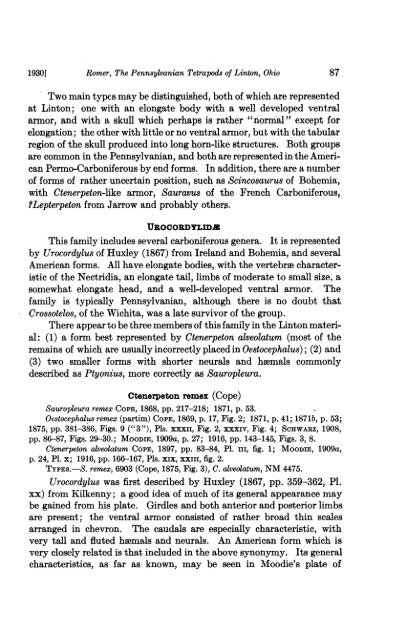View/Open - American Museum of Natural History
View/Open - American Museum of Natural History
View/Open - American Museum of Natural History
You also want an ePaper? Increase the reach of your titles
YUMPU automatically turns print PDFs into web optimized ePapers that Google loves.
19301<br />
Romer, The Pennsylvanian Tetrapods <strong>of</strong> Linton, Ohio<br />
Two main types may be distinguished, both <strong>of</strong> which are represented<br />
at Linton; one with an elongate body with a well developed ventral<br />
armor, and with a skull which perhaps is rather "normal" except for<br />
elongation; the other with little or no ventral armor, but with the tabular<br />
region <strong>of</strong> the skull produced into long horn-like structures. Both groups<br />
are common in the Pennsylvanian, and both are represented in the <strong>American</strong><br />
Permo-Carboniferous by end forms. In addition, there are a number<br />
<strong>of</strong> forms <strong>of</strong> rather uncertain position, such as Scincosaurus <strong>of</strong> Bohemia,<br />
with Ctenerpeton-like armor, Sauravus <strong>of</strong> the French Carboniferous,<br />
MLepterpeton from Jarrow and probably others.<br />
UROCORDYLIDZ<br />
This family includes several carboniferous genera.<br />
It is represented<br />
by Urocordylus <strong>of</strong> Huxley (1867) from Ireland and Bohemia, and selveral<br />
<strong>American</strong> forms. All have elongate bodies, with the vertebrae characteristic<br />
<strong>of</strong> the Nectridia, an elongate tail, limbs <strong>of</strong> moderate to small size, a<br />
somewhat elongate head, and a well-developed ventral armor. The<br />
family is typically Pennsylvanian, although there is no doubt that<br />
Crossotelos, <strong>of</strong> the Wichita, was a late survivor <strong>of</strong> the group.<br />
There appear to be three members <strong>of</strong> this family in the Linton material:<br />
(1) a form best represented by Ctenerpeton alveolatum (most <strong>of</strong> the<br />
remains <strong>of</strong> which are usually incorrectly placed in Oestocephalus); (2) and<br />
(3) two smaller forms with shorter neurals and hsemals commonly<br />
described as Ptyonius, more correctly as Sauropleura.<br />
Ctenerpeton remex (Cope)<br />
Sauropleura remex COPE, 1868, pp. 217-218; 1871, p. 53.<br />
Oestocephalus remex (partim) COPE, 1869, p. 17, Fig. 2; 1871, p. 41; 1871b, p. 53;<br />
1875, pp. 381-386, Figs. 9 ("3"), Pls. xxxii, Fig. 2, xxxiv, Fig. 4; SCHWARZ, 1908,<br />
pp. 86-87, Figs. 29-30.; MOODIE, 1909a, p. 27; 1916, pp. 143-145, Figs. 3, 8.<br />
Ctenerpeton alveolatum COPE, 1897, pp. 83-84, P1. iii, fig. 1; MOODIE, 1909a,<br />
p. 24, P1. x; 1916, pp. 166-167, Pls. xix, xxiii, fig. 2.<br />
TYPES.-S. remex, 6903 (Cope, 1875, Fig. 3), C. alveolatum, NM 4475.<br />
Urocordylus was first described by Huxley (1867, pp. 359-362, P1.<br />
xx) from Kilkenny; a good idea <strong>of</strong> much <strong>of</strong> its general appearance may<br />
be gained from his plate. Girdles and both anterior and posterior limbs<br />
are present; the ventral armor consisted <strong>of</strong> rather broad thin scales<br />
arranged in chevron. The caudals are especially characteristic, with<br />
very tall and fluted hemals and neurals. An <strong>American</strong> form which is<br />
very closely related is that included in the above synonymy. Its general<br />
characteristics, as far as known, may be seen in Moodie's plate <strong>of</strong><br />
87
















